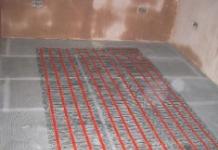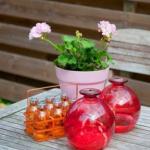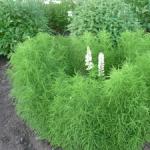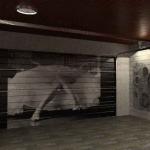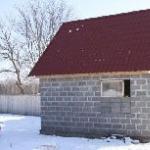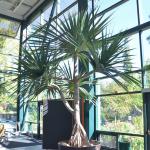Greenhouseis an artificial ecosystem that allows you to grow more southern crops all year round, plant and harvest ahead of time.
It is difficult to find a site where this structure of iron and glass or its substitute rises. Inclusions of artificial ecosystems have climbed far beyond the Arctic Circle and "expanded the habitat" of southern plants. In our article we will talk about not quite ordinary greenhouses.
Royal greenhouse in Laeken
Located at the royal castle of Laeken in Brussels (Belgium), the complex of greenhouses covers an area of more than 25,000 square meters. The greenhouses were built at the behest of King Leopold of Belgium in the 19th century and, among other things, include a church and a domed greenhouse-chapel. Visitors to the "royal greenhouse" are allowed once a year, during the mass flowering of "greenhouse" plants.


Photo sources: 1 , 2 , 3
Paradise Project
This artificial biosphere is located in Cornwall (South West England). Since the first opening (2001), more than 6 million people have already visited this giant greenhouse. The artificially created biomes of this greenhouse housed about a million plants from all over the Earth from various climatic zones.
An iron frame made of pipes in the form of honeycombs with plastic windows made it possible to abandon the columns supporting the vault. The rainforest biome alone covers about 1,600 square meters. At the same time, the dome reaches a height of 55 meters with a length of 200 meters and a width of 100 meters! 43% of the total amount of water needed to irrigate all this plant biodiversity is covered by rainwater, which is captured using special water intakes.
crystal palace
The Crystal Palace was located in London's Hyde Park and was probably one of the largest structures in the world, built of iron and glass. "Greenhouse Palace" was built in the late 19th century by Prince Albert for the fair. Thus, the prince decided to "boast" of the industrial achievements of Great Britain before the delegates of other countries. More than 13,000 exhibitions were simultaneously located in the Crystal Palace, which were visited by more than 6 million people.
After the closing of the fair, the palace was moved to the south of London, and at the beginning of the 20th century it was dismantled.
"House-greenhouse"
It is difficult to come up with a more original idea to live in a "house-greenhouse". You can grow vegetables and fruits right in the house. To make the house more comfortable at dusk, there is a movable wooden frame 28 meters long. I think that the owners living in this house have the impression that they have returned to the bosom of nature.
Greening the Sahara
In cold countries, conservatories, greenhouses and greenhouses are built to artificially create a warmer environment for plant organisms. In hot countries, the opposite is true. Greenhouse - acts as a saving screen that protects plants from hot and dry air. Evaporating moisture remains in a closed greenhouse system.
An ambitious project to green the Sahara is currently at the design stage. The creators of the project are going to get the water necessary for watering the plants and humidifying the air of the "greenhouses" by distilling sea water. Distillation will take place due to the energy of the Sun. Similar greenhouses are already operating in Tenerife, Oman and the United Arab Emirates.
Zonneterp
The Dutch company Zonneterp decided to build an artificial closed ecosystem. The essence of the project is as follows. Most greenhouses get rid of excess heat by opening windows. The Dutch believe that this is not rational. They propose to remove excess heat through watercourses. This heat is stored and used to heat the greenhouse at night and during the cold season. The stored heat is also enough to heat several buildings. Evaporating excess clean moisture should also not be wasted. It will condense and enter the drinking water supply system.
The Land of Thanet will probably be the largest greenhouse in the world. It will be possible to cover 80 football fields with the glass necessary for its construction. With the use of hydroponic technology, 90 hectares of "fields" (you can't say otherwise) greenhouses will cost 80 million pounds. This giant greenhouse has room for 1.3 million tomato, pepper and cucumber plants. The greenhouse will produce 2.5 million tomatoes per week!

Photo sources: 1
To print
Christina Mozgo 20.08.2014 | 4519
Folk wisdom says: prepare a sleigh in the summer, and a cart in the winter. This statement is also true when building a greenhouse. If you want to get an early harvest of greens or vegetables, then you should start building a greenhouse in late summer - early autumn.
1. For an early harvest
In order to be able to get an early harvest of heat-loving crops, and in the southern regions to grow vegetables and herbs almost all year round, I recommend building arched greenhouse. The main elements of its frame are arches made of a variety of materials: wood, rolled metal, pipes. The features of installation, operation and durability of the greenhouse depend on what material to use during construction.
2. For quick warming up of the soil in spring
Getting the first greens or young seedlings early in spring will help hovercraft greenhouse. Its main feature is the air isolation of the upper fertile layer of the earth from the cold lower one. If everything is done correctly, then the soil in such a greenhouse will be suitable for sowing seeds and planting seedlings 2-4 weeks earlier than in a conventional film greenhouse.
3. Durability plus economy
The main advantages of low greenhouses are durability, ease of care for plants and efficient use of the entire space. One of the members of this family is butterfly greenhouse. Due to its unusual design, in which the upper part acts as a door, vents and roof, the building is easy to ventilate. And the small size of the greenhouse makes it easy to care for the crops growing in it.
4. Plastic bottles - in business
Do you have a lot of empty plastic bottles? Don't know what to do with all this "good"? Build plastic bottle greenhouse. This building has several undeniable advantages: high strength, good thermal insulation, significant budget savings.
5. For early sowing seeds
In order to be able to sow the seeds of vegetables and flowers for seedlings much earlier than under normal conditions, I propose to make a small greenhouse-box. To work, you will need boards, an old window frame, door hinges, nails, a hammer and acrylic paint.
6. In the form of a pyramid
Pyramidal greenhouse not only captures the sun's rays well, but also distributes them evenly. It is a structure with an octagonal base, the individual parts of which are welded or fastened together with self-tapping screws or bolts. Another indisputable advantage of this structure is its convenience and original appearance.
7. Ideal for the southern regions
Pro greenhouse according to Mittlider many have heard, but not everyone knows what it is and how it "works". The main difference of this structure is the unusual shape of the roof, which has a ventilation transom. Thanks to her, the plants in such a greenhouse feel quite comfortable in any heat.
8. For "traveling" around the site
To avoid the annual replacement of the top layer of earth in the greenhouse, I propose to build a light portable greenhouse, which in the spring can be installed in any convenient place, and removed under the roof for the winter. No foundation is required for such a greenhouse, it is simply installed on concrete blocks or any other material at hand.
9. First - a greenhouse, then - a flower bed
Skillful craftsmen find application for any, even the most, at first glance, useless things. So, from an ordinary car tire, you can make a wonderful greenhouse for growing seedlings. And after the plants take their place in the beds, tire greenhouse can be easily transformed into a beautiful flower bed or garden bed for growing strawberries.
10. To save the family budget
If there is no place for a large stationary greenhouse on your site, I suggest building economy greenhouse. For it you will need a small piece of film, empty plastic bottles, wooden pegs and 1 hour of free time.
All described greenhouses and greenhouses differ from each other in shape, size and purpose. But they are united by the simplicity of construction and the excellent result obtained in the end. You just have to choose the appropriate option and get down to business as soon as possible, because the new summer season is just around the corner.
To print
Read today

Editor column Dacha is not only beds
The summer season ends. And this means that there will be less work in the garden and the garden and it will be possible to put things in order...
Each owner of a summer cottage sooner or later asks the question of how to increase the yield of the garden and optimize financial and physical costs. As a rule, it is after this that they begin to consider affordable greenhouses with their own hands: the best projects and features of their implementation. This article will discuss successful greenhouse designs, materials for construction and coating, as well as a detailed description of the process of building a building.
Before you start building a greenhouse, you need to decide on several fundamental aspects that will determine the size, type and location of the structure. First of all, you should think about what you plan to grow in it. For example, a greenhouse for tomatoes should match the height of adult plants, while growing seedlings exclusively does not require a large structure.

Another important point is the material from which the construction will be carried out. The most popular option, which is used in most cases, is wood. But today, wood has given way to lighter and more affordable modern materials, such as plastic pipes and covering material. But this does not mean that wooden frames were abandoned altogether. Wooden and metal greenhouses can still be found quite often.
In addition, the symmetrical arrangement of all buildings, fences and paths will help to give the site a neat appearance. But the most important thing is that at the same time, the greenhouse should be located correctly and do not close the windows of the house, do not block the passage, etc.
DIY wooden greenhouses and greenhouses: photos, instructions and material features
Wood is one of the most affordable and popular materials that is used for various construction. Of course, one cannot deny the fact that it is wood that is more than all other materials subject to the influence of external factors, however, this does not stop many owners of summer cottages who want to build a greenhouse with their own hands.

Soft wood species are acceptable for the construction of temporary structures. In this case, pine, alder, spruce, aspen or linden are suitable. For more reliable and permanent structures, it is better to use other deciduous trees or swamp cypress, larch.
In the process of building a greenhouse, the frame of which is made of wood, it is very important to prepare a reliable foundation that will become a solid foundation for the structure.
Do-it-yourself foundation options for a greenhouse and a greenhouse for a summer residence
Depending on the design features, one or another version of the foundation can be made, which will be suitable for this type of structure:
- foundation of railway sleepers or timber. To do this, you need to prepare a trench in which the sleepers or timber are laid. All these elements are connected with metal brackets. Then, a finished greenhouse frame is installed on top;

- for places where there is often windy weather, it is preferable to mount a columnar foundation. Due to the presence of a concrete base, this design can withstand severe wind loads, and even hurricanes. For this purpose, pipes with a diameter of more than 20 cm are required. They are dug in to a depth of 90 to 120 cm so that they do not freeze during the cold season;
- a block foundation is another solution to the issue of installing a base for a greenhouse or greenhouse. In this case, sand and gravel are first poured into a previously prepared trench, and then concrete blocks are placed. All this is poured with cement mortar and then a frame of bars is fixed on top;
- strip foundation is practically not used for greenhouses, as it is designed for more serious loads. A concrete pad 30-50 cm thick is located in a not too deep trench. The main advantage of this option is an extremely long service life, which allows you to change structures by installing them on the same base.
Do-it-yourself greenhouse frame assembly
Having figured out what is the difference between a greenhouse and a greenhouse, and having established the type of foundation that suits you, you can proceed directly to the construction of the frame itself. As mentioned earlier, there are several options that you can implement yourself, such as arched or gable construction. It all depends on your preferences, as well as the features of the area on which the installation will be carried out.

Most often in summer cottages you can find rectangular greenhouses or greenhouses with a gable roof. Making wooden greenhouses with your own hands is quite simple, and their use will be quite comfortable if you think through all the nuances.
Features of each stage of construction. How to choose and fix covering material. Advantages of PVC pipe constructions.
Installation always begins with the support beam, which is attached to the foundation and is usually somewhat thicker than the rest of the timber used for the frame itself. In this case, all elements are necessarily processed with a protective antiseptic.

All fasteners must be reliable, so reinforcement, anchor or metal bolts can be used for this purpose. Another important aspect is the integrity of the timber, which is used as a base. It must be solid, without cracks and traces of decay, since the stability of the structure depends on this.
The construction of a greenhouse made of wood with your own hands is carried out according to the drawing you have chosen. But, in general, the scheme of work is as follows: it is necessary to assemble two side and two end walls, which are then fastened together with self-tapping screws, corners, metal profiles or clamps.
When the "box" is ready, you can proceed to the installation of rafters. Their number depends on your preferences, however, it should be understood that the more there are, the easier it will be to fix the covering material and the stronger the overall structure will be.

When all the rafters are fixed, you can proceed to the installation of the roof ridge, which is attached to the upper groove of the rafters. At the same stage, it is worth fixing the wind boards, for which the side grooves of the rafters are provided. You can see more details on exactly how to do this in the drawing or diagram. All these elements must be made of solid material.
The final stage of construction can be called the installation of a doorway, as well as a vent, which is provided for ventilation. After that, it remains only to cover the frame with a covering material, and you can begin operation.
Helpful advice! One of the most effective ways to protect against rodents is to lay a chain-link mesh with small cells under the greenhouse. This must be done before installing the frame.

The most comfortable do-it-yourself greenhouses. Photos of models made of polycarbonate and plastic pipes
One of the modern and inexpensive options for building a greenhouse is the use of plastic pipes. Depending on the manufacturing technology, they are divided into polypropylene, metal-plastic and PVC.
The last option is slightly cheaper than all the others. But metal-plastic, although the most expensive, are able to provide a much higher level of strength. Therefore, in this case, you should be guided by your preferences and financial capabilities. As an example, you can see photos of greenhouses in the country with your own hands.
The main advantages of a plastic greenhouse frame over a wooden one are ease of installation and the ability to give the structure any shape. As in the case of wood, you need to start construction with site selection and site preparation. Having decided on the purpose and size of the greenhouse, you can proceed to the drawing of the scheme and the purchase of the appropriate amount of necessary materials.

Often, plastic pipe structures are made temporary, since they can be easily dismantled and reassembled several times. The type of foundation to be laid depends on whether the greenhouse is stationary or collapsible. In the first case, it is better to use tape or columnar. For a temporary structure, you can not make a foundation at all, but simply dig in metal pins and strengthen the site with boards.
With the help of pins, the base is made as follows:
- Strong metal pins are dug into the ground. They should protrude about 30 cm above the ground.
- One end of the pipe is put on the pin.
- The pipe is bent in such a way that the second edge can also be put on the pin, which is dug parallel to the first.

How to economically build a greenhouse with your own hands from plastic pipes
Everyone can make a simple greenhouse with their own hands without much financial investment and effort. To do this, you only need to purchase all the necessary materials, according to the selected drawing and follow a fairly simple algorithm:
- After the base arcs are installed, it is necessary to fasten them together. To do this, you need to use a pipe, the length of which will correspond to the length of the entire greenhouse.
- A long pipe (or two short ones fastened together) is located in the center of the arcs standing on the base, and is fixed as tightly as possible with clamps or ropes. On this, the assembly of the frame can be considered certified.
- As a coating, it is best to use polycarbonate or polyethylene film. In the first case, the thickness of the polycarbonate must be at least 4 mm, and the size of the sheet can be any, since this material can be easily cut and adjusted to the size of the greenhouse. In the second case, the film is cut into strips and attached to the arcs using double-sided tape, stationery binders or special pipe mounts.
- Fastening of polycarbonate or film must be overlapped. To connect the sheets, you can use self-tapping screws with wide caps or thermal washers. The main thing is to pay due attention to the sealing of the joints. To do this, you can use a special tape.

Small ones for greenery can be built with your own hands from improvised materials
Greenhouse made of covering material: which is better, polycarbonate or film
The technical and operational characteristics of polycarbonate have allowed it to take a leading position among the materials that are used to create greenhouses and hotbeds. It is quite simple to cut and fasten, and at the same time it is resistant to external factors. In addition, it has excellent light transmission, providing plants with the necessary amount of sunlight.
It is worth considering that this durable and reliable material is much more expensive than the usual and affordable polyethylene film, which is still widely used to cover greenhouses.
Everyone can figure out how to cover a greenhouse with a film. The main thing is to fix it on the frame as securely as possible and fix it below, sprinkling the edges with earth and laying heavy boards or bricks. When deciding which film to choose for a greenhouse, you should first of all be guided by its strength. But in any case, most likely, it will not last more than one season. The price of a film for a greenhouse is affordable, so you can replace it without much effort and investment.

As for the features of fastening polycarbonate, it is worth noting the presence of several different methods. So, in addition to conventional self-tapping screws, you can use aluminum staples or special plastic earrings.
Another option involves the use of profiles for this purpose. In this case, you need to drill holes in advance that will allow you to attach the coating to the metal frame.
Helpful advice! The use of thermal washers in the process of fixing polycarbonate is a mandatory measure, since this is what allows the material to maintain integrity and prevents condensation.
Greenhouse "Do it yourself" from window frames: how to equip a place for growing seedlings
In garden plots, you can often find small greenhouses assembled from old window frames. Of course, such a design is hardly suitable for growing tall and large crops, but it is more than useful as a do-it-yourself greenhouse for seedlings.

The main advantage of this option is financial savings. All you need is old window frames. If they have glasses, then you can leave them and use them instead of the standard coating. If the frames are empty, then after installation they can be covered with plastic wrap or cut polycarbonate sheets can be inserted.
Even for such a small and light greenhouse, it is necessary to prepare the foundation in advance. For this purpose, a wooden frame made of boards or timber is mounted. Best suited for this purpose is a beam of 50x50 mm or a board with a thickness of 40 mm.
The frame will consist of racks, as well as upper and lower straps, which are made from the same boards. Racks, at the same time, must be installed at such a distance from each other that the window frame can enter between them.
For the roof, timber is best suited, as it is more durable and minimizes the risk of the greenhouse being destroyed under the weight of snow in winter. Also, gable structures are more durable, which is also worth considering.

As for attaching the frames themselves to the supports, this can be done using nails and screws. It must be fixed on all four sides, both from the outside and from the inside. All remaining gaps must be sealed with foam.
Like the walls of the greenhouse, it is best to cover the roof with polycarbonate or wrap it with a film. This will provide the plants with the maximum amount of light.
Helpful advice! It is best to start the installation of the coating from the roof, gradually moving down. Otherwise, you run the risk of damaging already covered areas by hitting them in the process.
Do-it-yourself greenhouse under a film made of galvanized steel profile
Profile is another material that has recently been actively used for the construction of greenhouses and greenhouses. The main advantage of this method is the ability to give the structure absolutely any shape and size, not limited to any standard sizes.

Helpful advice! In order to build a beautiful and reliable greenhouse with your own hands from a profile, videos, calculations and step-by-step photo instructions offered on the Internet can serve you well. Do not neglect the advice of experts, as well as the recommendations of users who have already had to work with such buildings before.
To work, you will need the following tools: a measuring tape, a building level and a plumb line, scissors designed to work with metal and a screwdriver.
Installation of the frame begins with fixing the guide profile, which is attached to the foundation with self-tapping screws. One upper beam should connect all sections to each other, which should be at such a distance that the structure is sufficiently rigid. As a rule, the step is the third and fourth part of the length of the polycarbonate sheet.

By the same principle, you can make a galvanized greenhouse under the film. You just need to think in advance how to fix the film on the greenhouse. Otherwise, the technology does not differ from that used for wooden structures and greenhouses made of plastic pipes.
Very often, a galvanized profile is used for a greenhouse for tomatoes. It is quite simple to build it with your own hands, and at the same time, the design has the proper strength. Moreover, every summer resident, interested in the question of how to grow tomatoes in a greenhouse, will definitely come across the fact that the temperature in the greenhouse for tomatoes should not fall too low. Therefore, it may be worth thinking about the heating system at the design and construction stage.
How to care for the structure and how to prepare a greenhouse for planting
Regardless of whether you prefer a greenhouse under a film or a more fundamental structure using polycarbonate, a number of procedures must be carried out before planting plants. First of all, this concerns the preparation of soil and beds in a greenhouse with your own hands. Photos and diagrams of how to properly arrange everything inside clearly demonstrate that having calculated everything in advance, you can ensure the convenience and ease of working with plants.

When wondering how to treat a greenhouse in the spring before planting, it is worthwhile to study in detail all possible methods in order to protect the plants and the building. First of all, it should be a high-quality antiseptic that will destroy all dangerous microorganisms living in the soil.
Considering the question of which is better, a greenhouse or a greenhouse, it is also worth considering that the first option is often installed on open ground, and from year to year the structure can be moved to a new location. And the greenhouse is a stationary structure, and it will not be possible to move it without effort.
Another important point is how to make beds in a greenhouse. Here you need to build on what kind of crop you plan to grow. For example, if you start building a greenhouse for peppers with your own hands, then the width of the beds should be at least 80 cm. At the same time, the paths should be thought out in such a way as to provide free access to each plant.

The most convenient do-it-yourself greenhouse: video instructions for making
After reviewing the video, a do-it-yourself greenhouse will no longer seem like an impossible task to you. Following simple recommendations, you can easily make a greenhouse made of covering material with your own hands, which will meet all your needs, and is perfect for the effective cultivation of vegetable crops.
In the traditional sense, a greenhouse is rarely associated with sophisticated design. In our country, this concept includes a prefabricated or stationary structure that allows you to grow various plant crops without a clear reference to the season. However, the experience of foreign countries shows that even ordinary polycarbonate greenhouses can really surprise and delight the eye with an unusual design. Our selection is devoted to such designs.
This is not just a greenhouse, but a whole biosphere complex, opened back in 2001. In fact, the "Paradise Project" is a huge winter garden and greenhouse, which contains hundreds of thousands of plants brought here from all over the world. At its core, the complex is a metal frame of their pipes, and the windows are made of plastic. The height of the dome is 55 meters, while almost all climatic zones are represented in the greenhouse, from temperate to tropical.

The Sahara is the largest desert on the planet, so the idea to grow a Garden of Eden here was quite bold. The essence of this greenhouse is that the evaporating moisture does not escape, but remains inside the system.

And this unusual design occupies as much as 25 thousand square meters and is located in Brussels. The complex was erected by the personal decree of King Leopold over a hundred years ago. Getting inside is not easy. The Royal Orangery receives tourists only once a year during the flower season.

Another temple of vegetation is located in London and is one of the largest greenhouses in the world. The design, indeed, is a palace, or rather, a whole kingdom of glass and metal. It is noteworthy that the greenhouse was built in the distant 19th century, but this does not prevent it from surprising tourists and gathering huge festivals. True, according to reports, at the moment the palace is not functioning.

